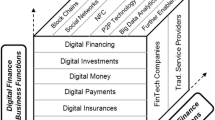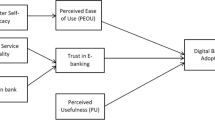Abstract
The increased adoption and infiltration of the Internet has recently redefined the playground for retail banks. Retail banks are now offering their services primarily through their Internet banking branches. The repercussions of this change to “brick and mortar” banks have been studied in the context of developed market economies. In this paper, we contribute to the literature by studying the impact of Internet banking adoption on banks’ deposit collection, lending activities, and performance in an emerging market setting. By using a panel of 18 retail banks that operate in Turkey from 1990–2008, we demonstrate that Internet banking adoption has a positive impact on the level of profits, deposits and loans per branch. As operational activities are now provided via Internet branches, Internet banking facilitates banking activities in branches that require more human input. We also find that Internet banking adoption has a negative impact on bank profitability after 2 years of adoption as Internet banking increases competition and results in lower interest income. Accordingly, Internet banking complements brick and mortar branches.
Similar content being viewed by others
Notes
Chaffai et al. (2001) show that environmental differences across countries in Europe influence productivity gains from technological advancements.
He does not specify which emerging markets’ banks were analyzed in the study.
Alper and Öniş (2004) provides a detailed analysis of the structure of the Turkish banking sector from 1988–1999.
Please refer to Alper and Öniş (2004) for a more detailed discussion of banking sector developments in the Post-1990s era in Turkey.
Abbasoglu et al. (2007) provide a detailed list of banks that were acquired by the Deposit Saving Insurance Fund (TMSF), banks that were merged, and banks whose licenses were revoked in the aftermath of the crisis.
Available online at www.tbb.org.tr.
Of the 14 banks that were not included in our sample, 8 banks engaged in only corporate banking without an Internet branch, 2 banks didn’t have an Internet branch, and we were unable to retrieve adoption dates and details for the remaining 4 banks.
Caprio et al.’s (2005) index does not cover the year 2005 and afterwards; we use our own observations regarding the state of the Turkish banking system and economy in populating the data point for this year.
DEPOSITTA is not included as an explanatory variable in the estimation of this equation.
LOANTA is not included as an explanatory variable in the estimation of this equation.
PERNO is not included as an explanatory variable in the estimation of this equation.
Following Hernando and Nieto (2007) INTERNET dummy is the transformation of a transactional internet banking dummy, which equals 1 if the bank has a transactional website and 0 otherwise.
BRANCHNO is included only to regression estimates of BRANCHPROFIT, BRANCHDEPOSITS and BRANCHCREDIT measures to account for the changes in these ratios due to changes in the number of bank branches.
We also construct a crisis dummy following De Haas, and Van Lelyveld (2010), where we define crisis period as [t, t + 2] with t being the start of the crisis period. Our results remain the same.
Hausman (1978) test confirms use of fixed effects.
We define a bank as foreign if the share of the foreign ownership exceeds 50.01% following IFRS standards.
For foreign banks that are not listed on the local stock exchange even though their parent holding company is listed on the stock exchange of another country, this variable takes a value of zero.
Instruments for INTERNET dummy is obtained using the transactional internet dummy in the probit equation as in Hernando and Nieto (2007). The listed, foreign and large dummies significantly enter the equation with a positive coefficient, while state dummy significantly enters with a negative coefficient. The correlation between the transactional internet dummy and the fitted value of the random probit model is 0.59.
The relevant χ 2 values for Levin, Lin and Chu(2002) test are ROA = 94.89, ROE = 100.57, DEPOSITTA = 64.87, NONINTINC = 83.91, BRANCHPROFIT = 83.73, BRANCHCREDIT,=-7.67825, BRANCHDEP = -8.08447, NPLOANS = -1.24458, BRANCHNO = 1.90450 PERNO = 48.98, and INTINC = 40.75.
The STATA code for Petersen(2009) estimation can be downloaded at: http://www.kellogg.northwestern.edu/faculty/petersen/htm/papers/se/se_programming.htm.
Standard errors of the FE model with firm level clustering is higher than the White Standard errors, while we find no such result for year level clustering and hence we prefer to use 1 dimension clustering rather than 2.
We cannot carry out the same analysis for interest paid on deposits by banks due to unavailability of data.
Results not reported here, but available upon request.
Please see Claessens et al. (2001).
References
Abbasoğlu OF, Aysan AF, Gunes A (2007) Concentration, competition, efficiency and profitability of the Turkish banking sector in the post-Crisis period. MPRA Paper No. 5494
Akyuz Y, Boratav K (2002) The making of the Turkish financial crisis. In United Nations Conference on Trade and Development, 2002
Allen F, McAndrews JJ, Strahan P (2002) E-finance: an introduction. J Financ Serv Res 22:5–27
Alper EC (2001) The Turkish liquidity crisis of 2000: what went wrong. Russ East Eur Financ Trade 37:51–71
Alper EC, Öniş Z (2004) The Turkish banking system, financial crises and the IMF in the age of capital account liberalization: a political economy perspective. New Perspect Turk 30:25–54
Altunbas Y, Goddard J, Molyneux P (1999) Technical change in banking. Econ Lett 64:215–221
Banks Association of Turkey (2009) Annual report on internet banking, December
Beck T, Demirguc-Kunt A, Levine R (2003) Bank concentration and crisis. NBER Working Paper No. 9921
Berger A (1995) The relationship between capital and earnings in banking. J Money Credit Bank 2:432–256
Caprio G, Klingebiel D, Laeven L, Noguera G (2005) Appendix: banking crisis database. In: Honohan P, Laeven L (eds) Systemic financial distress: containment and resolution. Cambridge University Press, Cambridge, pp 169–96
Centeno C (2004) Adoption of internet services in the acceding and candidate countries, lessons from the Internet banking case. Telemat Inform 21:293–315
Chaffai ME, Dietsch M, Lozano-Vivas A (2001) Technological and environmental differences in the European banking industries. J Financ Serv Res 19:147–162
Ciciretti R, Hasan I, Zazzara C (2009) Do Internet activities add value? Evidence from the traditional banks. J Financ Serv Res 35:81–98
Claessens S, Glaessner T, Klingebiel D (2001) E-Finance in emerging markets: is leapfrogging possible? Financial Sector Discussion Paper No. 7. The World Bank
Claessens S, Glaessner T, Klingebiel D (2002) Electronic finance: reshaping the financial landscape around the world. J Financ Serv Res 22:29–61
Clemons EK, Hitt LM, Gu B, Thatcher ME, Weber BW (2002) Impacts of E-commerce and enhanced information endowments on financial services: a quantitative analysis of transparency, differential pricing and disintermediation. J Financ Serv Res 22:73–90
Daniels KN, Murphy NB (1994) The impact of technological change on household transactions account balances: an empirical cross-section study. J Financ Serv Res 8:113–119
Demirguc-Kunt A, Huizinga H (1999) Determinants of commercial bank interest margins and profitability: some international evidence. World Bank Econ Rev 13:397–408
De Haas R, Van Lelyveld I (2010) Internal capital markets and lending by multinational bank subsidiaries. J Financ Intermed 19:1–25
DeYoung R (2005) The performance of internet-based business models: evidence from the banking industry. J Bus 78:893–947
DeYoung R, Lang WW, Nolle DL (2007) How the Internet affects output and performance at community banks. J Bank Finance 31(4):1033
Egland KL, Furst K, Nolle DL, Robertson D (1998) Banking over the Internet. Quarterly J Offic ComptrolCurr 17:25–30
Elyasiani E, Mehdian SM (1990) A non-parametric approach to measurement of efficiency and technological change: the case of lare U.S. commercial banks. J Financ Serv Res 4:157–168
Fisher R (1932) Statistical methods for research workers, 4th ed. Oliver and Boyd, Edinburgh
Furst K, Lang WW, Nolle DL (2002) Internet banking. J Financ Serv Res 22:95–117
Gurau C (2002) Internet banking in transaition economies: the implementation and development of internet banking systems in Romania. Int JBank Mark 20:285–296
Hausman JA (1978) Specification tests in econometrics. Econom 46:1251–1271
Hernando I, Nieto MJ (2007) Is the Internet delivery channel changing banks’ performance? The case of Spanish banks. J Bank Finance 31(1):083–1099
Im K, Pesaran M, Shin Y (2003) Testing for unit roots in heterogeneous panels. J Econom 115:53–74
Jayawardhena C, Foley P (2000) Changes in the banking sector: the case of internet banking in the UK. Internet Research: Electron Netw Appl Policy 10:19–30
Kaminsky GL, Reinhart CM (1999) The twin crises: the causes of banking and balance-of-payments problems. Am Econ Rev June: 473–500
Lee EJ, Eastwood DB, Lee J (2004) A sample selection model of consumer adoption of computer banking. J Financ Serv Res 26:263–275
Levin A, Lin C, Chu C (2002) Unit root tests in panel data: asymptotic and finite-sample properties. J Econom 108:1–24
Petersen MA (2009) Estimating standard errors in finance panel data sets: comparing approaches. Rev Financ Stud 22:435–480
Polatoglu VN, Ekin S (2001) An empirical investigation of the Turkish consumers’ acceptance of internet banking services. Int JBank 19:156–165
Simpson J (2002) The impact of the Internet in banking: observations and evidence from developed and emerging markets. Telemat Inform 19:315
Sullivan RJ (2000) How has the adoption of Internet banking affected performance and risk at banks? A look at Internet banking in the tenth federal reserve district. Financ Ind Perspect (December):1–16
Tanyeri B (2010) Financial transparency and sources of hidden capital in Turkish banks. J Financ Serv Res 37:25–43
Zilberfarb BZ (1989) The effect of automated teller machines on demand deposits: an empirical analysis. J Financ Serv Res 2:49–57
Acknowledgements
The authors would like to thank Stijn Claessens, Daniel Nolle, the participants of the 37th Eastern Economic Association Meeting in New York 2011, the participants of 18th Multinational Finance Society Meeting in Rome 2011 and an anonymous referee for their valuable comments and assistance in the writing of this paper.
Author information
Authors and Affiliations
Corresponding author
Appendix
Appendix
Rights and permissions
About this article
Cite this article
Onay, C., Ozsoz, E. The Impact of Internet-Banking on Brick and Mortar Branches: The Case of Turkey. J Financ Serv Res 44, 187–204 (2013). https://doi.org/10.1007/s10693-011-0124-9
Received:
Revised:
Accepted:
Published:
Issue Date:
DOI: https://doi.org/10.1007/s10693-011-0124-9




